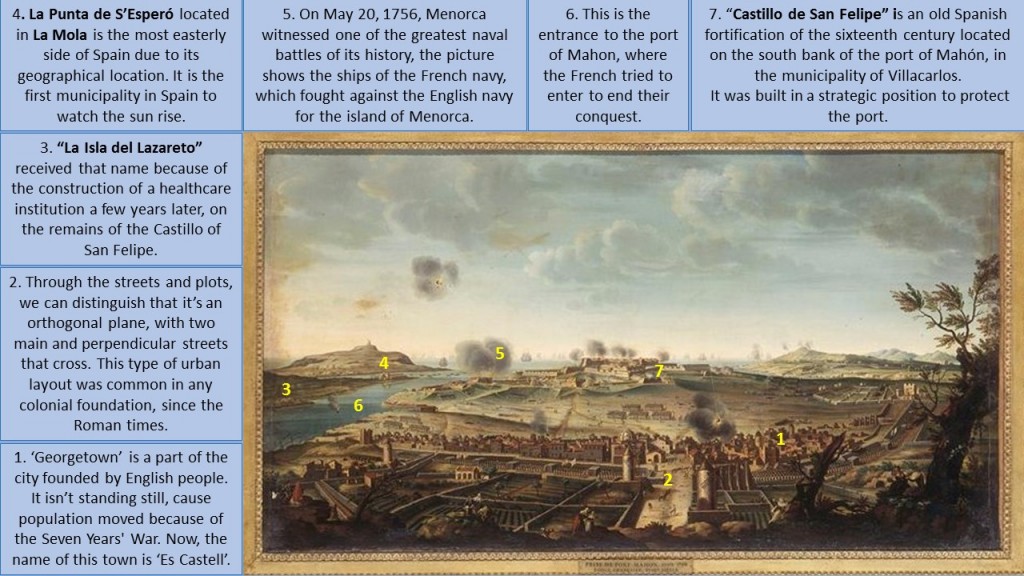On May 20, 1756, Menorca witnessed one of the greatest naval battles in its history; Britain and France fought to control the island. The French had already invaded the island and the only part resisting was the Castle of San Felipe, under the British in control. This picture, made by Jean-Baptiste Martin le Jeune (1700-1778), represents the attack and capture, on the French side, of the castle. It was on June 29, 1756, when the capitulation of the British took place and Menorca ended up belonging to France. The image is located in the Palace of Versailles as a testimony for political propaganda.
The Castle of San Felipe began to be constructed in 1554 to defend the port of Mahón from the attacks of Turks and Berberis. That menace was very common in Western Mediterranean during Modern Times, concretely after the Barbarroja assalt to Mahón in 1535. In the year 1558, the fortifications of the castle were already armed and in order to repel the Ottoman attack. That perception of defense stimulated many inhabitants to live near the walls of the castle and finally formed a permanent urban nucleus that, over the years, grew and was known as the Arrabal de Sant Felip.
Because they were too close to the fortifications of the castle, during the conflict with France in the 18th century, the place was devastated and the population moved further away, to Raval Nova. The new urban nucleus was founded in 1771 by the British with the name of Georgetown in honour of the King George III of England during the period in which Menorca was under British dominion. This is possible to appreciate by looking at the figure of St. George killing the dragon in the coat of arms. When the island was recovered by Spain in 1782, it turned its name to Real Villa de San Carlos in honour to the king Carlos III of Spain, later abbreviated to Villacarlos. Due to its geographical situation, it is the first municipality of Spain to watch the sun rise, being, therefore, the true Spanish uprising. Today Villacarlos is a municipality of the community of the Balearic Islands, located in the east of Menorca, at the mouth of the port of Mahon. Its current name is ‘Es Castell’.
The urban area that appears in the image represents s’Arrabal de Sant Felip, the old urban core of which nothing remains. It was based on an orthogonal or reticular plan, and it offers a very simple layout with perpendicular streets and a spacious square of arms in the center, surrounded by barracks. This type of urban layout was common in any colonial foundation, since the Roman times.
The Castle of San Felipe is one of the first strongholds star fortress of Spain, that is to say, bastions with «walls of curtain» that had the shape of a pentagon and two flanks. Its floor was square, with four bastions joined by four curtains, surrounded by a narrow and deep moat excavated in the stone. When the Britons of Menorca were possessed, the castle was greatly enlarged with lunettes and revellines united by subterranean galleries that shaped its starry shape. The castle was flown by order of the Spanish government in 1782. Many of the castle’s ashlars were used for the construction of a Lazareto (Sanitary enclosure dedicated to the observation and treatment of disinfection of people who may be carriers of a contagious disease) that can still be seen in the homonymous island. The Lazareto of Mahón was constructed in 1793 by order of the Count of Floridablanca, minister of Carlos III. It is currently a holiday residence of the Spanish Ministry of Health and Consumer Affairs.
Years later, after the demolition of the castle, in 1852, La Fortaleza de la Mola was constructed during the reign of Isabel II. It was built to protect the entrance to the port from the other side of the mouth, as a defense mechanism against the possibility of a British invasion, interested in recovering the island due to its strategic geographical location for trade routes and to overthrow France. The building itself is impressive and one of the most advanced military works for the time. This fortress is also one of many testimonies about the interest in dominating the island throughout the history of Europe. Although destroyed, you can still visit the ruins and part of the underground galleries of the castle, still impressive enough to give an idea of what San Felipe was in its best moments.
Some factors that have a vital importance for the economy are the cattle raising and the manufacture of cheese with denomination of origin «Mahón / Menorca» (Cheese of Mahón), as well as footwear industry, leather goods and skin in general, jewellery, bakery, charcuterie and other small industries that form the second pillar of the economy, which is much more remarkable than on other islands and an alternative to tourism. In addition, Menorca was declared a Biosphere Reserve in 1993 because of its high degree of compatibility between the development of economic activities and the conservation of its natural and historical heritage. The favourable environmental and geographical conditions that the island has a great potential for self-sufficiency with renewable energies.
Laura de la Peña Aguilera

